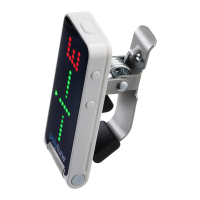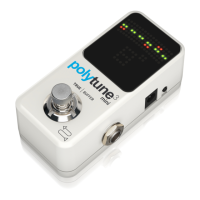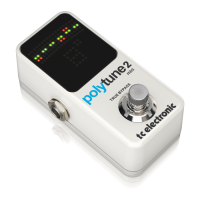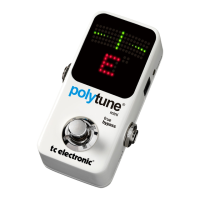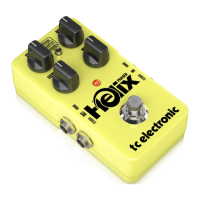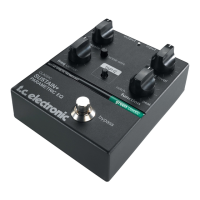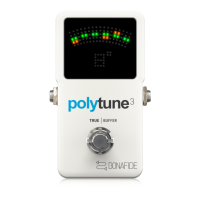
Do you have a question about the TC Electronic POLYTUNE 3 and is the answer not in the manual?
| Best uses | Guitar |
|---|---|
| Product type | - |
| Product color | White |
| Output impedance | 100 Ω |
Details the items included in the TC ELECTRONIC effect pedal box and how to inspect them for transit damage.
Explains how to connect a 9V power supply, instrument, and amplifier to the POLYTUNE 3 for operation.
Explains the hard-wire bypass feature and its benefits for tone preservation when the pedal is bypassed.
Describes the bright LED display and ambient light sensor for optimal visibility in various lighting conditions.
Details the fast and precise strobe tuning mode with high pitch detection accuracy for fine-tuning.
Explains how the pedal stores user preferences like pitch reference and tuning modes even after power off.
Connects a 9V power supply to power the pedal and minimize hum, using a standard DC plug.
Provides power to other daisy-chained guitar pedals from the pedal's power out jack.
Sets the tuning mode for the instrument, storing the selection for future use.
Allows installation of firmware updates by connecting the pedal to a computer via USB.
Switches between the various display modes on the POLYTUNE 3 for tuning visualization.
The bright LED display provides a clear readout of tuning status in various lighting conditions.
Automatically adjusts display brightness based on ambient light for optimal visibility and battery life.
Connects the instrument to the pedal via a 1/4" jack for tuning and signal processing.
Connects the pedal's output to the next device in the signal chain.
Turns the tuner on or off, mutes output for silent tuning, and features a true bypass circuit.
Explains the difference between chromatic and polyphonic tuning and how POLYTUNE 3 excels.
Describes how to cycle through and interpret the different display modes like Guitar/Needle or Bass/Strobe.
Details how pitch is indicated by LEDs in Needle mode and how to achieve an 'on target' indication.
Explains how to interpret the rotating segments in Strobe mode to achieve accurate tuning.
Explains that polyphonic tuning works automatically by strumming the instrument.
Provides steps to set the POLYTUNE 3 to the popular 'Drop D' tuning mode.
Details how to use the TUNING MODE button to select various alternate tunings and capo settings.
Instructions on how to adjust the standard reference pitch (e.g., 440 Hz) for tuning.
Answers the common question about not hearing sound when the tuner is active.
Explains that an instrument must be connected to the audio input for the footswitch to function.
Clarifies the meaning of the red '#' symbol, indicating the pedal is ready but not bypassed.
Provides tips for achieving the most accurate tuning, such as using the neck pickup.
Explains the difference between True Bypass and Buffered Bypass modes and when to use each.
Details the procedure for switching bypass modes using DIP switches inside the pedal.
Outlines the requirements and steps for updating the pedal's built-in software (firmware).
Provides instructions on how to replace the battery in the TC ELECTRONIC effect pedal.

